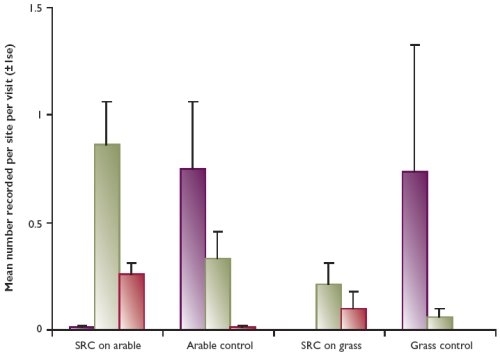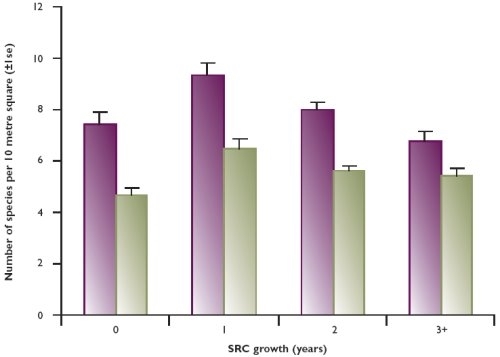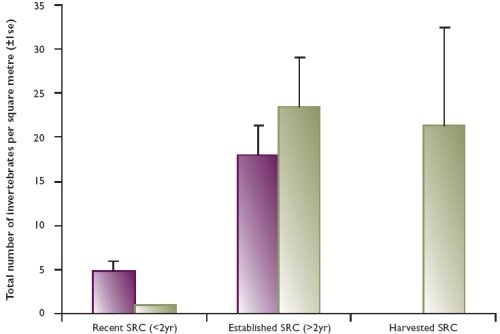Key findings
- In winter, snipe and woodcock prefer short rotation coppice crops to arable and grass fields nearby.
- As the SRC crop established, perennials in the ground flora took over from annuals.
- As the crop matured, the headlands of SRC attracted higher numbers of butterflies than the controls.
- The canopy of SRC attracted a diverse insect fauna.
Short rotation coppice (SRC) is likely to become a widely grown energy crop. Since 2005 we have been studying 22 commercially grown willow SRC plantations, linked to the ARBRE renewable energy project in South Yorkshire. Of these, 12 were planted on arable land and 10 on grassland. Each of the SRC plantations were paired with arable and grassland controls.
Once established, SRC plantations rapidly develop into a scrub habitat, and attract a different bird community from arable and grassland. Finches (0.75 ± 0.07 per hectare), thrushes (0.46 ± 0.05 per hectare), tits (0.64 ± 0.08 per hectare) and warblers (1.08 ± 0.07 per hectare) were all more abundant in the SRC. Migrant warblers were especially common, with approximately one singing willow warbler per hectare in spring. Overall there were more bird species in the SRC (6.60 ± 0.30 per visit) than in the controls (2.40 ± 0.19 per visit), both in the SRC and along its edges.
One aim was to determine if birds associated with open farmland would be displaced by planting SRC. We found few skylarks on grassland controls (0.09 ± 0.02 per hectare), so SRC would be unlikely to harm their numbers in this habitat. Crows (0.58 ± 0.16 per hectare) and starlings (0.41 ± 0.16 per hectare) were more abundant in grassland and may be displaced, so SRC could reduce their populations. The arable controls did have more skylarks (0.15 ± 0.03 per hectare) than established SRC, which did not support this species. However, recently planted or cut SRC supported more skylarks (0.31 ± 0.08 per hectare) and lapwing (0.85 ± 0.25 per hectare) than the arable controls. SRC is harvested approximately every three years and this creates an open habitat which suits these species.
In winter, although lapwings were hardly recorded on SRC sites, both snipe and woodcock were three and 20 times, respectively, more common in the SRC (see Figure 1). 86% of cut and standing SRC plantations supported woodcock at some point during the winter, and 73% held snipe. Snipe numbers varied between years, with a maximum of 20 birds recorded from a single plot at any one visit.
Figure 1: Average number of wintering waders in SRC plantations compared with arable and grass

We sampled vegetation within 1x10 metre quadrats at various distances from the edge of the SRC and control crops during July. We counted the plant species present within each quadrat, and categorised them into annuals and perennials. Recently planted/harvested SRC was dominated by annual plants, such as groundsel, fat hen and creeping thistle. With growth, the proportion of annuals declined and perennials increased. The number of different plant species increased by 39% after one year's growth with, on average, 31% more at the crop edge (see Figure 2). Vegetation cover increased by 34% in the first year with, on average, 44% more cover at the crop edge than the crop interior.
Figure 2: Number of plant species in the edge and interior of 22 SRC plantations at different growth stages

We surveyed the headlands of SRC and control plots for butterflies by walking transects for an hour three times during the summer. The headlands around the SRC plantations supported more butterflies, such as browns and skippers, than control areas. The more mobile and generalist 'white' butterflies were common everywhere, ranging from 12.52 ± 3.92 per hour in ex-arable SRC to 5.19 ± 1.30 per hour in grassland. 'Blue' butterflies were more abundant around the ex-grassland (1.38 ± 0.45 per hour) than ex-arable plantations (0.30 ± 0.13 per hour), although this could reflect the slightly more southerly location of the ex-grassland plots. Numbers of butterflies increased by 130% in the ex-arable SRC plantations as the willow crop established and more sheltered conditions became available.
We collected invertebrates by beating the willow stems three times during the summer between May and August. Numbers were higher in established SRC plantations than in recently planted ones (see Figure 3). We identified 15 different groups in the SRC plantations; with Hemiptera (true bugs) and beetles being the most abundant, especially in July/August. We also found high numbers of blue willow beetle (25% of total invertebrates collected), which is the major insect pest of coppice willow.
Figure 3: Number of canopy invertebrates found per metre square in recent SRC, established SRC and SRC harvested in the previous year

Acknowledgements
The Central Science Laboratory and Future Energy Solutions, funding by the Department of Trade and Industry.